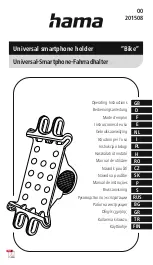
SKC fitted across PLC pins 2 and 3, SKO fitted
across PLO pins 1 and 2 and SKE fitted across PLE
pins 2 and 3. The earth loop recall connections are
SKC fitted across PLC pins 1 and 2, SKO fitted
across PLO pins 2 and 3 and SKE fitted across PLE
pins 1 and 2.
1 1 5 Link A is not fitted on commercial versions of
KT1 and KT 4. For 200 x 200 ohm feeding bridge
systems, fit SKB to pins 1 and 2 .of PLB. For some
overseas installations using 400 x 400 ohm feeding
bridge systems and when using the KT 1 or KT 4
telephone with a KBX 1 0 or KBX 1 00 system, fit SKB
to pins 2 and 3 of PLB.
11 6 The main integrated circuit, IC 1, may be either
the TMC 1 31 7 or TMC 1 61 7, but for on chip timed
break recall options, IC 1 must be the TMC 1 61 7.
Various link and bridging connections may be used to
provide such options as no recall, earth loop recall, or
timed break recall (discrete or on chip) or alternative
recall. These links are conveniently listed with Figure
7.
117 Capacitors C9, C1 7, C18, C19, diodes 03,
05 and R26 are not fitted at present but provision is
made for them for future development.
1 1 8
TR 1 provides current amplification during
speech periods as the circuit is configured as a
current source in series with the loop. TR2 is also
fitted when on chip TMC 1 61 7 timed break recall or
alternative recall is required. R9 is provided to give a
small bias current for TR2 which is used to start up
the circuit.
11 9 The signal from the microphone is amplified by
about 24dB by the IC microphone amplifier which is
of a special low noise design. The microphone
amplifier also provides a d.c. level-shift function
which is applied, together with the amplified
microphone signal to the base of TR 1 .
1 20
The signal from the line is obtained via an
attenuator R5 and R7 and is fed into the earphone
amplifier via C6, where it is summed with the
sidetone signal from the microphone amplifier to
provide sidetone cancellation. The earphone output
stage consists of
a
large enhancement transistor with
an active driven load to provide the drive required by
a 600 ohm earphone.
1 2 1 Both the microphone and earphone amplifiers
have a line displacement gain which is controlled by
the AGC system. This circuit takes a voltage from the
d.c. control block which is similar to that found on
the base of TR 1 and compares it with a voltage refer
ence multiplier circuit.
3513 300 05070
13
1 22 Operation of any of the twelve keypad push
buttons causes the circuit to change from speech to
tone mode. The on chip oscillator oscillates at the
parallel resonance of XL 1, which is 560kHz. The
microphone and receive paths are switched off, but a
small signal is fed from the tone generators to the
earpiece (confidence tone). The duration of any tone
is a minimum of 70ms, but will remain for the dura
tion of the pushbutton operation. There is a 70ms
'silent' period at the end of each tone, when no tones
or speech can be sent.
1 23 Links E and G are not currently required, but
provision for their incorporation caters for future dev
elopment. Link F is fitted only when tone levels of -6
to -8dB are required.
1 24
For KT
1
Series telephones, C4 is 4 70 µf, R6 is
fitted and link B is omitted. For the KT 4 version, C4 is
220 nf, R6 is omitted and link B is fitted.
125 C1 is used to trim the value of C2. If C2 is 2.7
µf, C1 is omitted.
INSTALLATION
1 26
The PCB link connections and other compo
nents selected for various options are detailed in the
previous section and in the appropriate circuit
diagrams, Figures 2 to 7. With the exception of the
feed bridges, the options are fitted in the factory
before despatch, to suit the site requirements, and
should need no further adjustment before instal
lation.
1 2 7 Both the KT 1 and KT 4 Series instruments are
normally free-standing on a desk or table, but the
KT1 Series may be wall-mounted, if required. For the
wall-mounted version, the wall-bracket assembly
should be installed in position as illustrated in Figure
1 0. The wall plate is fixed to the wall by three wood
screws and the line cord routed so it can be con
veniently plugged into the base instrument. The base
instrument itself is attached to the base plate which
can then be securely placed into the wall plate
housing.
1 28
The instrument has a 3 metre line cord with
one of the following end connectors:
1) British Telecom plug 431 A (used in
conjunction with a British Telecom master
line jack unit. containing a bell capacitor).
2) Block Terminal 52A.
3) Western Electric plug.
Содержание KT1 Series
Страница 1: ...KT1 KT4 Series Telephones LD and MF Versions Servicing Handbook KT1 Series TMC Limited KT4 Series...
Страница 20: ......
Страница 23: ......
Страница 26: ......
Страница 29: ......
Страница 32: ......
Страница 35: ......
Страница 38: ......
Страница 41: ......
Страница 46: ......
Страница 47: ......
Страница 50: ......
















































